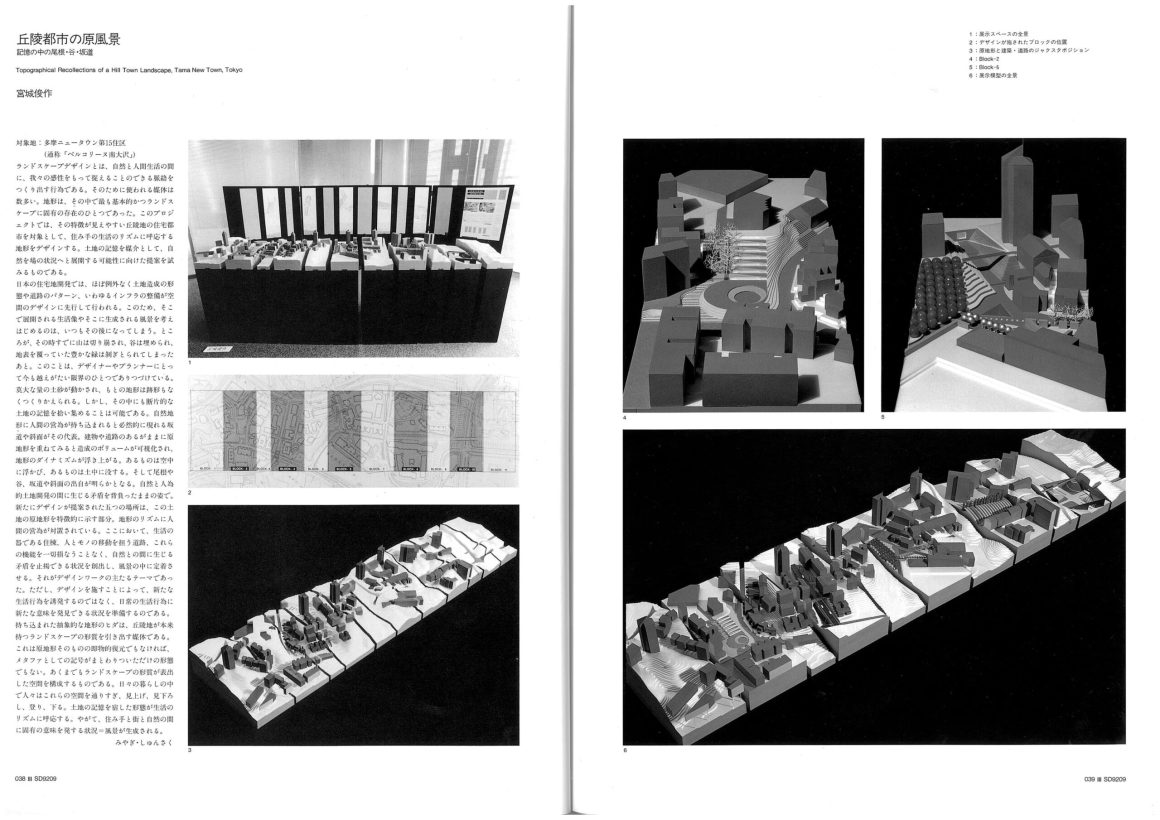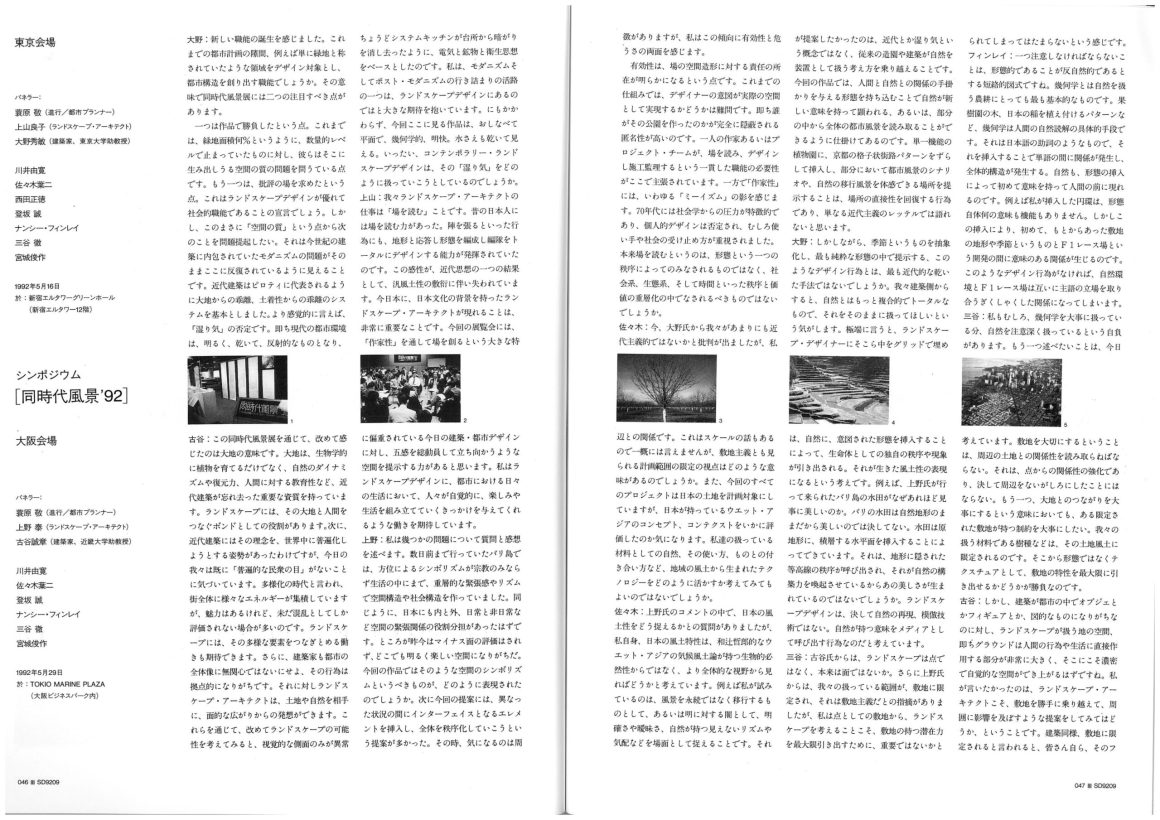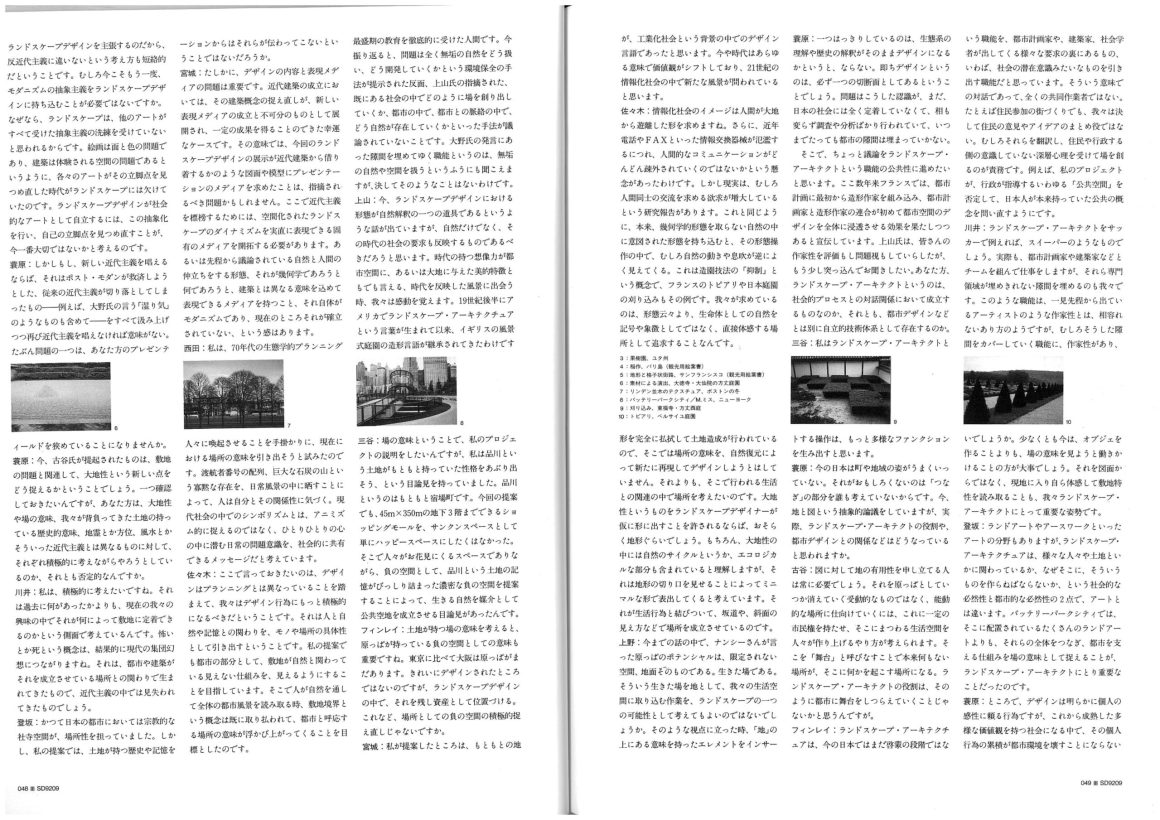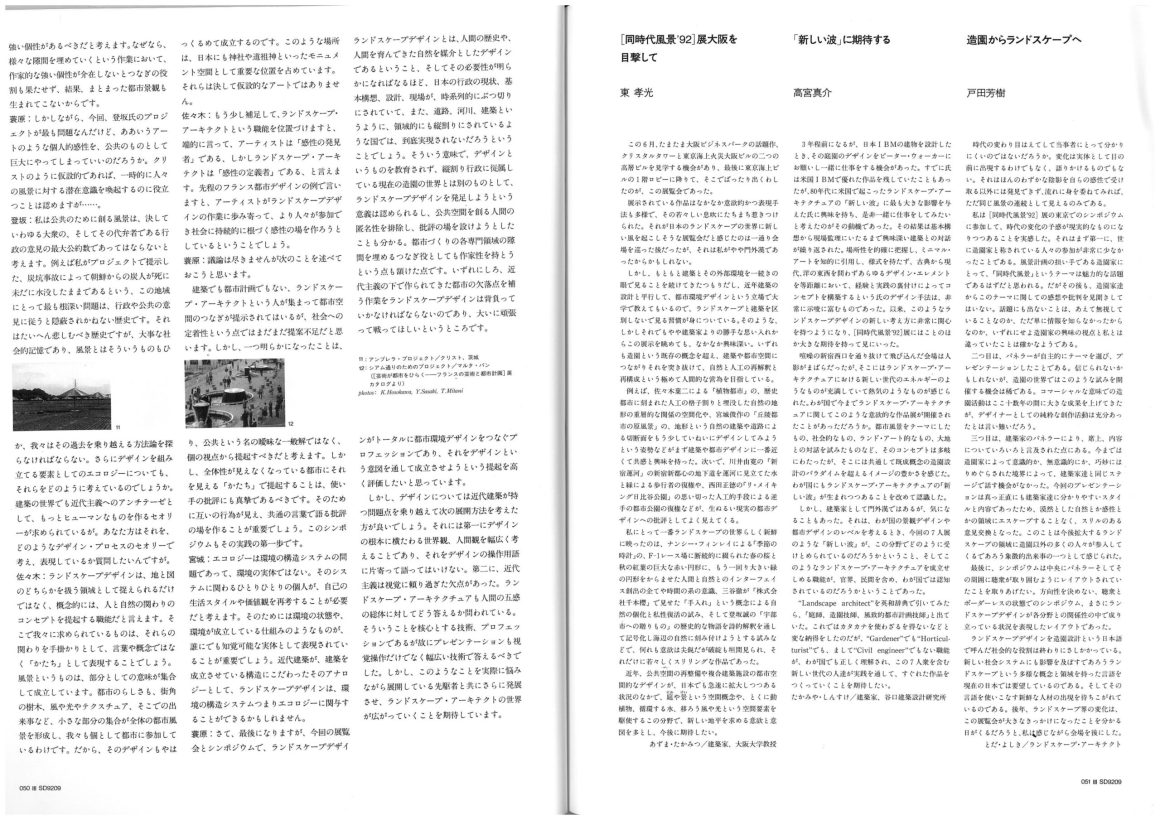专访前言:
木藕游学,每期链接一家顶级事务所。
新推出的游学专辑,专为景观人定制,除了精选景观项目参访以外,加入了事务所探访及名师讲座环节,让每个人都有机会与大师面对面,在旅行中打开视野,在交流中有所收获。
本文访谈内容来自木藕日本游学链接的事务所PLACEMEDIA:向日本失落三十年成长起来的景观公司设问,寻找相似境况下的可参考经验。
*受访人:
吉村纯一,PLACEMEDIA创始合伙人,日本多摩美术大学教授
吉泽真太郎,PLACEMEDIA新晋合伙人,日本武藏野美术大学现任讲师
Interview Record.
PART ONE.
Start in the silence of the industry
在一片寂静中启程
1990年日本爆发经济危机,各行各业陷入一片萧条,宫城俊作、吉村纯一、吉田新、山根明这四位十年前的同级校友却在此时选择重新聚在一起逆流而上。
彼时已跟随日本造园始祖铃木昌道十年的吉村纯一,从哈佛大学深造掌握美国前沿技术和理念的宫城俊作,以及有了十年建设施工经验的吉田新,对日本景观行业现状颇感不安,期望向外界输出完全不同于当下浮华景观的设计理念。
Shunsaku Miyagi, Junichi Yoshimura, and Susumu Yoshida, three classmate 10 years after graduation come together and started PLACEMEDIA. And a few years later,Yoshiaki Yamane joined them. When the company was founded, Japan was in a post-bubble recession.
At that time, Yoshimura had followed the pioneer of modern Japanese gardening, Shodo Suzuki, for ten years. Miyagi had studied at Harvard University and mastered the cutting-edge technologies and ideas from the US. Yoshida had ten years of construction experience. And Yamane,an engineer,developed his experience as a lanscape architectural consultant.They were deeply concerned about the current state of the Japanese landscape industry and hope to convey a completely different design philosophy from the current flashy landscape designs.
↑ PLACEMEDIA创始合伙人(从左至右):吉田新、宫城俊作、吉村纯一、山根喜明
PLACEMEDIA Founding Partners (from left to right) : Susumu Yoshida,Shunsaku Miyagi,Junichi Yoshimura and Yoshiaki Yamane.
我们想做什么?面对日本高速发展三十年(1960-1990)留下的华丽浓妆,三位认为景观的本质并非在场地创造吸引眼球的装饰物,而是帮助焕发场地本身的自然风貌、历史文化等特质。因此将公司取名为PLACE MEDIA,意为“场所的媒介”。他们将设计师比作人与场所之间的中转站(即媒介),通过自己的美学思考和技术经验,还原场地鲜为人知的魅力,让风景自然显现。
What do we want to do? Facing the gorgeous decoration left by Japan’s rapid development for three decades (1960-1990), the three believe that the essence of landscape is not to create eye-catching decorations in the site, but to help revitalize the natural and cultural characteristics of the site itself. Therefore, they named their company PLACE MEDIA, meaning “the medium of place”. They compare designers to the intermediary between people and places, using their aesthetic thinking and technical to reveal the hidden charm of the landscape. Make the scenery appear naturally.
↑ 植村直己纪念公园,1994。没有在公园中创造易破旧过时的华丽设计物,而是引导最佳的视线欣赏场地远处的美丽山景森林和稻田
Naoki Uemura Memorial Park, 1994. Instead of creating an ornate design in the park that is easily worn out and outdated, it leads the best view to enjoy the beautiful mountain scenery, forests and rice fields in the distance of the site.
↑ 种植一排树,形成画框强调环境特质。在没有这些设计之前,几乎没人意识到这里有如此美丽的风景
Plant a row of trees to form a frame to emphasize the character of the environment. Before these designs, almost no one realized that there were such beautiful scenery here.
PART TWO.
How to survive in a recession
萧条期的生存方式
没有业务的时候就有了更多时间去自由表达。市场上没有工作机会,他们就将自己的理念以概念的形式呈现出来,用比较低廉的资金投入参加各种展览或举行景观主题活动,由此获得同频的人认可。两三年间,PLACEMEDIA果然逐渐收到越来越多的客户委托营造各类景观场所,前文提到的植村直己纪念公园就是该途径获得的项目之一。
No business, but there is more time for free expression. When there are no job opportunities in the market, they present their ideas in the form of concepts and participate in various exhibitions with relatively low budget investment, thereby gaining recognition from people who are on the same wavelength. Over the course of two or three years, PLACEMEDIA did receive more and more commissions to create various landscape places, and the Shimura Naoyuki Memorial Park mentioned earlier is one of the projects obtained through this approach.
↑宫城在“当代景观’92”展览暨研讨会上的作品。来源:SD杂志,1992年9月
Miyagi’s works at the exhibition + symposium “Contemporary Landscape ’92”
Source: SD Magazine, September 92
PART THREE.
Differences between China and Japan
当前中日差异
社会上的生态意识不一样。吉村纯一结合当下的工作状态,认为现在的日本,即使是东京繁华市中心的项目,又或者边远工厂的更新项目,人们对生态环境的保护已经是普遍的共识。
对于普通群众来说,近年来频发的高温等各种气候恶化每个人都正在经历,对环境感到忧心使得人们反过来督促政府和建设单位采取生态可持续的开发措施,不合理的开发和过度干预,将不会被认可,甚至会受到严重批判。
正如“绿色投资”所代表的那样,民间投资也开始受到是否考虑环境的质疑。而且对景观设计的需求和要求也越来越高。
The ecological awareness in society is changing. According to current projects, Yoshimura has found, Whether it is a project in the center of Tokyo or a remote factory construction project, people’s protection of the ecological environment has been a general consensus.
For the general public, the recent frequent occurrence of high temperatures and other deteriorating climate conditions that everyone is experiencing has made people worried about the environment, which in turn has led them to urge the government and construction units to take ecologically sustainable development measures. Unreasonable development and excessive intervention will not be accepted, and may even be severely criticized.
Private-sector investment, as represented by “green investment,” is increasingly being questioned as to whether it is environmentally friendly. And demand and requirements for landscape design are also increasing.
↑ 由当地植物组成的工厂景观设计有助搭建广域生态系统网络
Landscape design of the plant composed of local plant materials contributes to a wide area ecological network.
↑ 更新这条溪流之前,PLACEMEDIA实施生态调查,捕获建设前栖息在池塘里的,建设后再次放生到池塘里。
Ecological survey was conducted, and the ponds that were inhabited before construction were captured and released back into the ponds after construction.
传统上来说,人们边界意识不太一样。回答关于中日差异的问题时,吉村补充了他认为的另一点:中国传统建造城市以围墙保护不受他地侵扰,百姓也习惯围院造园,私享一方天地,边界意识清晰。日本历来战乱较少,城市以天然山体为屏障,因此每个场地互有联系。而景观的本质,并不是在封闭的场地里面创造华丽的新事物,是通过建立与周围的联系,让场地内部的关系浮现出来。
场地虽然有边界,但设计不应有边界。
Traditionally, people have a different sense of boundaries. In response to a question about the differences between China and Japan, Yoshimura added another point he believed: the Chinese tradition of building cities with walls to protect them from other invaders, and the common people used to build courtyards and gardens to enjoy their own world and have a clear sense of boundaries. Japan has historically been less war-torn, and cities are protected by natural mountains, so each site is connected to the other. The essence of the landscape is not to create gorgeous new things inside the closed site, but to allow the relationship within the site to emerge by establishing a connection with the surrounding area.
Although the site has boundaries, the design should not have boundaries.
PART FOUR.
Design methods that are always applicable
永远适用的设计方法
保留大自然的魅力。回顾34年来的各种项目,当前国际上流行的热词,例如韧性景观、环境动向关注等,吉村认为公司过去的许多项目都有在实践,虽然当时还没出现这些词汇,但足以证明团队的一些工作理念放到现在仍然适用,且同样适用于未来。
PLACEMEDIA的新书,不仅是对以前工作的总结,同时也涵盖了现在的工作内容,以及与未来工作的联系。比如“保留自然魅力”的设计方法。
Preserving the natural charm. Looking back on the various projects of the past 34 years, the current international hot words, such as resilient landscape, environmental trends, etc., Yoshimura believes that many of the company’s past projects have been in practice, although these words did not appear at the time, but it is enough to prove that some of the team’s working concepts are still applicable now, and also applicable to the future.
PLACEMEDIA’s new book is not only a summary of previous work, but also covers current work and how it relates to future work. For example, the design method of “preserving the natural charm”.
↑ 京都六善酒店,还原京都东山自然之景。虽然庭院面积很小,但设计师并没有配合场地尺寸改用小型树木来模仿自然,而是选择常规高度的赤松来还原真实的自然魅力
Six Senses Kyoto, restoring the natural scenery of Dongshan Kyoto. Despite the small size of the courtyard, the designers did not use small trees to mimic nature. Instead, choose the regular height of red pine to restore the nature.
↑ 酒店温泉室,窗外狭窄的崎岖山体,再现东山的岩石肌理。不是简单地引入绿植,而是让人们聚焦在这一点。设计师希望把在大自然中能看到的山景,带到这里给你看
The SPA room, outside the window of the narrow rugged mountain, reproduce the rock texture of Dongshan. Instead of simply introducing greenery, people focus on the rocks outside the window. The designers want to bring the mountain scenery in nature to show you here.
如果要给出建议或寄语,你会对行业后辈或新人说些什么?
What advice or message would you give to the next generation or newcomer in the industry?
吉村纯一:上周我在九州参加一场景观活动,很多人问我到底应该怎么学习?
我说,请去玩吧,去滑雪,去海边冲浪……只有你去体验自然,感受自然,你才会真的热爱自然,发现气候变化、海水污染各种环境问题。你会在玩的过程中收获新的思考,所以,我想如果你玩得越多,你会学到更多。这是我的回答。
吉泽真太郎:就像现在和大家分享一样,我也在大学教那些从将要开始做景观的人,我们是在同一个领域朝着同一个方向努力的伙伴,在分享我们迄今为止积累的知识的同时,以前的机制正在发生越来越大的变化,各种智能工具也在不断发展。作为新时代的伙伴,我会践行我的景观理念不会改变,所以,即使我们在不同的公司,做着不同的工作,坚信我们将永远前行,共勉。
Yoshimura: I was at a landscape event in Kyushu last week, and a lot of people asked me how exactly should I study?
I said, please go play, go skiing, go to the beach to surf…… Only when you go to experience nature, feel nature, you will really love nature, find climate change, sea water pollution and other environmental problems. You will gain new ideas while playing, so I think if you play more, you will learn more. This is my answer.
Yoshizawa: As I share with you now, I also teach those who are going to start doing landscape design in the university, we are partners working in the same field and in the same direction, while sharing the knowledge we have accumulated so far, the previous mechanisms are changing more and more, and various intelligent tools are constantly evolving. As a landscape architect in the new era, I will practice my landscape concept will not change, so even if we are in different companies, doing different jobs, I firmly believe that we will always move forward, mutual inspiration.
PLACEMEDIA partially represents works.
END
Thanks again to Yoshimura and Yoshizawa for accepting an exclusive interview with mooool!
Read more about PLACEMEDIA.






















0 Comments